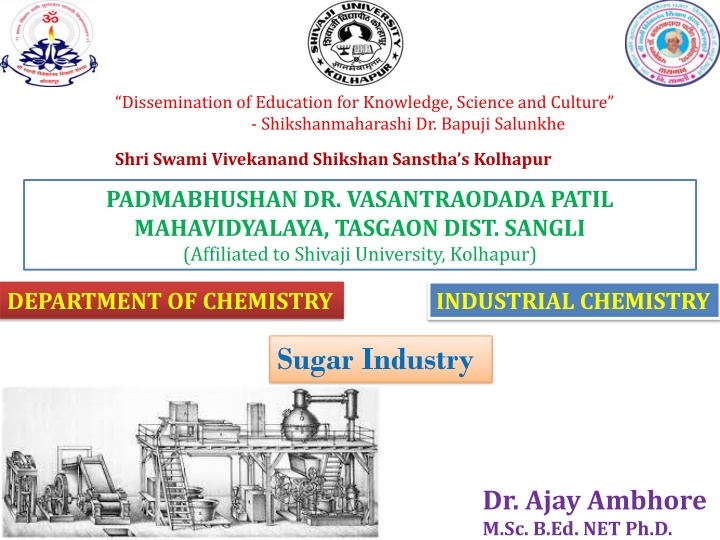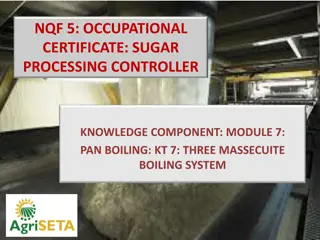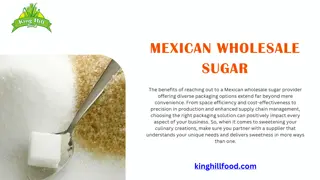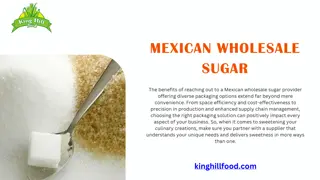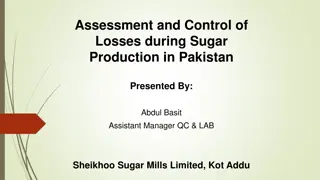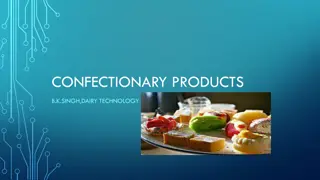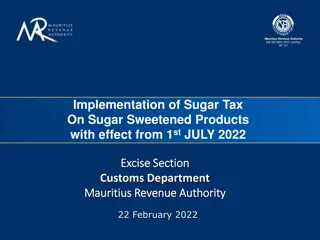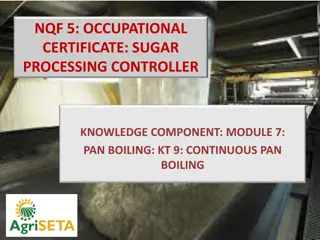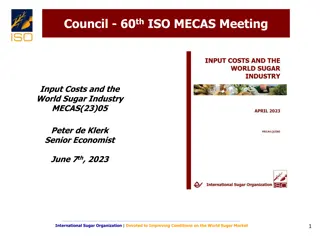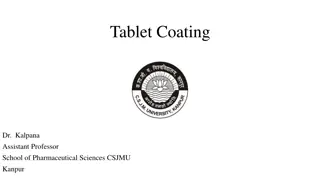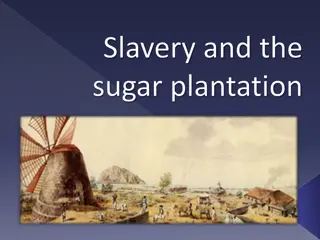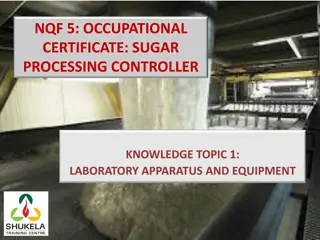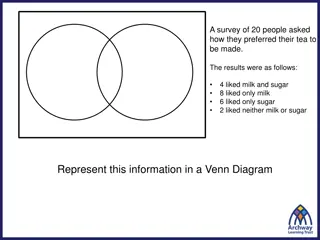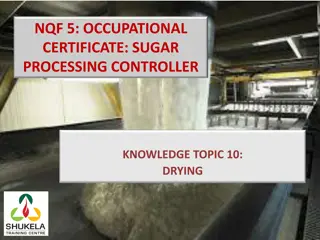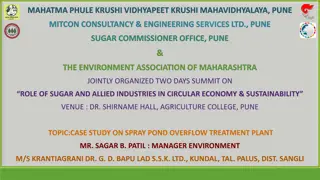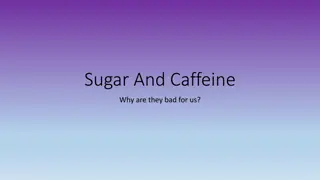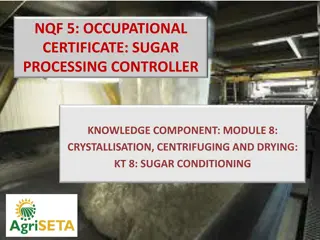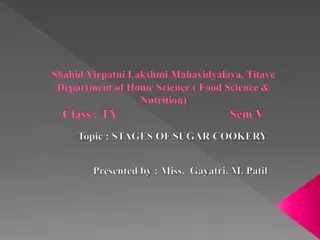Evolution of the Sugar Industry: From Ancient Times to Global Production
Explore the historical journey of the sugar industry from ancient cultivation practices to modern global production, highlighting key milestones such as the introduction of sugar production in India, global production statistics, and the intricate process involved in manufacturing sugar. Discover the cultural significance and economic impact of sugar as a commodity that has shaped societies worldwide.
Download Presentation

Please find below an Image/Link to download the presentation.
The content on the website is provided AS IS for your information and personal use only. It may not be sold, licensed, or shared on other websites without obtaining consent from the author.If you encounter any issues during the download, it is possible that the publisher has removed the file from their server.
You are allowed to download the files provided on this website for personal or commercial use, subject to the condition that they are used lawfully. All files are the property of their respective owners.
The content on the website is provided AS IS for your information and personal use only. It may not be sold, licensed, or shared on other websites without obtaining consent from the author.
E N D
Presentation Transcript
Dissemination of Education for Knowledge, Science and Culture - Shikshanmaharashi Dr. Bapuji Salunkhe Shri Swami Vivekanand Shikshan Sanstha s Kolhapur PADMABHUSHAN DR. VASANTRAODADA PATIL MAHAVIDYALAYA, TASGAON DIST. SANGLI (Affiliated to Shivaji University, Kolhapur) DEPARTMENT OF CHEMISTRY INDUSTRIAL CHEMISTRY Sugar Industry Dr. Ajay Ambhore M.Sc. B.Ed. NET Ph.D.
Sugar Production introduced by India in world Cultivation of Sugar cane in Bengal region from 1500-500 BC Extraction of juice from sugar cane from 400 BC Sugar production in India from 350 AD Crystallization of sugar in 17th century. Commercial production of sugar start in 18th century.
Sugar Industry Near about 110 countries produce sugar in the world from Cane sugar or beet. Production of sugar globally in the year 2019-20 is about 170 million metric tons. Production of Sugar Globally
Sugar Industry Consumption of Sugar yearly
Sugar Industry Top 10 Sugar Produced Countries
Sugar Industry Production of Sugar Extraction Purification Refining
Sugar Industry Manufacture of Sugar Extraction Clarification Concentration Crystallization Centrifugation Refining
Sugar Industry Manufacture of Sugar
Sugar Industry Manufacture of Sugar Extraction of juice Milling Train
Sugar Industry Manufacture of cane Sugar Extraction of juice
Sugar Industry Manufacture of cane Sugar Extraction of juice 1st mill 2nd mill 3rd mill 4th mill Crusher Total 70 % 12.5 % 7.0 % 4.5 % 2.0 % 96 %
Sugar Industry Clarification of juice Removing of impurities from cane juice is called Clarification or defecation. Raw Juice : Acidic in nature; Greenish in colour. Impurities Soluble impurities Organic matters Insoluble impurities Inorganic matters inorganic Salt crystalline sugar/ proteins/organic acids/pectins / etc Clay/ fibers/ path/ etc
Sugar Industry Clarification of juice Lime defecation method: Addition of lime (Cao) Calculated amount: 0.5 Kg/ ton of cane Increase pH up to 8.5 Reduce loss of sucrose by hydrolysis Precipitate soluble acids and phosphates Coagulation of colloidal partials like proteins/pectins/ gum etc due to increase in pH Precipitate out clay/ fibers/ path etc Addition of phosphoric acid and super phosphate:
Sugar Industry Clarification of juice Juice Heater Heating for coagulation and settling of soluble proteins Juice heater having brass tubes. Juice heated by high pressure hot steam. Juice and steam are travel through the tubes in opposite direction. Juice heated up to its boiling point.
Sugar Industry Clarifier Clarification of juice Clarifier: settling tank Upper layer: Scum : fiber particles Middle layer: clear juice Lower level: heavy particles : mud By product of this step : Manure
Sugar Industry Clarification of juice Multiple effect Evaporator Steam chamber/ Calandria Juice chamber Concentration of Juice to Syrup Use steam with reduced pressure. Juice become more concentrate to form syrup. Multiple effect evaporator is energy economy. Reduce loss of sugar due to decomposition.
Sugar Industry Crystallization of Sugar Vacuum Pan Single effect vacuum pan/ Strike pan
Sugar Industry Crystallization of Sugar Graining: Sucrose concentration in the syrup is raise to supersaturation Crystallization done by Waiting method: Supersatiration is broken by gradually cooling Shock treatment method: Supersaturation broken by Sudden chilling Decreasing rate of steam Increasing vacuum Mixing large amount of cold syrup In India external seed grains are added for crystalization About one ton added sugar crystals recover 25 to 30 ton massecuite
Sugar Industry Crystallization of Sugar Crystal Growth: When graining point is reached, sucrose forced out from the syrup by Addition and mixing of syrup in lots Maintain the vacuum (28.5 inches) Crystal growth till the required grain size is attain During this process avoid formation of false grains (False grain- minute crystals are formed in between the perfect crystals which hamper the crystal growth) Finally formed Massecuite (Massecuite = Sucrose + Molasses and 10 % water) Massecuite sent to crystallization tank
Sugar Industry Crystallization of Sugar Crystallization Tank: Horizontally rotating tank which moves slowly and having cooling attachment Massecuite cool gradually at 336-341 K which reduce the solubility of sucrose and crystallization occurs Crystallization of sugar in vacuum pan is called Sugar Boiling Three boiling are required for maximum recovery of sugar Boiling 1st Massecuite -A Molasses - A Boiling 2nd Massecuite -B Molasses - B Boiling 3rd Massecuite -C Molasses - C
Sugar Industry Crystallization of Sugar Massecuite A = 80-85 % blending syrup with molasses A Massecuite B = 70-75 % blending syrup with molasses B Massecuite A Sent to centrifugation for recovery of Sugar A and B Massecuite B (to form commercial sugar) Massecuite C = 60-55 % blending syrup with molasses C Low purity and highly viscuss Sent to crystallization and allow to stay for 4-5 days Add additional sugar and sent to centrifuge to recover sugar C and molasses C (black strap) Sugar C is used for seeding purpose in boiling
Sugar Industry Clarification of juice Centrifugation Separation of sugar crystals from mother liquor by centrifugation force Centrifugation tank:
Centrifugation tank: Cylinder perforated basket (400-600 perforation per inch) Hot massecuite rotate in the basket at the speed of 1800-2400 rpm Due to centrifugation force massecuite drawn to the wall of cylinder The syrup drain through perforation where as sugar crystals held within Crystals covered with massecuite hence brown in colour which is then wash with water spray Centrifugal basket rotate till the sugar crystals is dry which then collect manually
Sugar Industry Refining of Raw Sugar Unit Operations 1. Affination 2. Defecation 3. Decolorization 4. Crystallization and centrifugation 5. drying
Sugar Industry Refining of Raw Sugar 1. AFFINATION Raw sugar are further mixed with heavy syrup (mother liquor) of 60 -80 brix (Brix = Density scale of sucrose solution) Mixing in a vessel having stirrer called Mingler Remove only the colored impurities of molasses film around the sugar crystals Crystals then centrifuge to separate from mother liquor and washed with hot potable water During washing sugar crystals melted in water at 55-60 brix Melting of sugar is done in a melting vessel called Melter This syrup then sent to defecation process
Sugar Industry Refining of Raw Sugar 2. Defection At this stage sugar syrup having some insoluble impurities like clay, gum, pectins, etc These impurities are removed by the process of liming, sulphonation and carbonation Lime is added up to natural pH and then heat the syrup Impurities are precipitated out which then filtered Addition of diatomaceous earth enhance the process of defection
Sugar Industry Refining of Raw Sugar 3. Decolorization Filtered syrup obtained from defecation process has dark brown in colour because of impurities still remain in it It pass through bed of bone charcoal in a char tank The colored impurities are selectively adsorbed on charcoal to obtain clear, pure and colorless syrup Disadvantages: Takes longer time Inorganic salts are not removed After the process charcoals are reactivated and use for next batch
Sugar Industry Refining of Raw Sugar Alternative methods for purification of Sugar i) Activated carbon process: Addition of pulverized charcoal directly into the colored syrup for defecation and then filter Take short time
Sugar Industry Refining of Raw Sugar Alternative methods for purification of Sugar ii) Ion exchange process: Colored syrup pass through both cation and anion exchange resin Charge impurities are retrained on ion exchange column to form uncharged sucrose Expensive but repetitively used process
Sugar Industry Refining of Raw Sugar Alternative methods for purification of Sugar iii) Sulphitation process: Use of SO2 gas for defection process Double sulphitation is employed
Sugar Industry Refining of Raw Sugar Alternative methods for purification of Sugar vi) Carbonation process: Excesses amount of lime is used to precipitate out the impurities Same process explained in lime defecation process
Sugar Industry Refining of Raw Sugar 4. Crystallization and Centrifugation After defecation process , sugar syrup become dilute It is sent to a vacuum pan to concentrate it under reduced presser The formed massecuite then sent to crystallizer Crystallization is done by centrifugation to form sugar crystals The mother liquor formed in this step is used for refining of raw sugar of next batch (in affiation step)
Sugar Industry Refining of Raw Sugar 5. Drying process The sugar crystals are formed was contain 1-2% moisture It can dried in granulator, a horizontally rotating drum In granulator the sugar is dried by passing hot air blown in opposite direction
Manufacturing of White Sugar in India Manufacturing of sugar in single step without producing raw sugar 1. Extraction of juice: Compound imbibition process 2. Clarification of juice: Raw juice contains Sucrose (10-20%), reducing sugar (0.5-2.5%), organic matters (0.5-1%), water (78-86%), ash (0.3-0.7%) pith, fiber and some colloidal particles a) Sulphination defecation process: Addition of lime and heated to 333K (1-2 kg lime/ton cane) Colloidal particles and soluble impurities like phosphates separate by coagulation due to increasing pH Suplhur dioxide (SO2) gas bubbled out through the juice to brought accelerate the pH 7 and sedimentation of coagulated particles SO2 also helps to bleach the juice
Manufacturing of White Sugar in India b) Carbonation defecation process: Addition of lime and heated to 333K (8-12 kg lime/ton cane) Non sugar and coloring matters separate out completely because of high alkalinity Carbon dioxide (CO2) gas bubbled out through the juice to accelerate the sedimentation of coagulated particles which are the filters Resituate the CO2 by boiling the juice to Break the bicarbonate form and to remove the remained contaminant Cheaper method than sulphination
Manufacturing of White Sugar in India 3. Concentration of juice: Triple effect evaporator used to convert juice to syrup 4. Crystallization of sugar: Syrup converted to massecuite in crystallization or strike pan 5. Centrifugation: Separate the sugar crystals from mother liquor
Sugar Industry By-products of Sugar industry Complete utilization of by-product: Reduce operational coast Provides additional employments Reduce waste management risk
Sugar Industry By-products of Sugar industry Bagasse: Cane residue expelled from milling house It contain solid matter and water with some quantity of sucrose Applications: Energy Source Manufacture of hard board like celotex Manufacture of Cattle feed Manufacture of paper for printing news paper Manufacture of furfural from the pith
Sugar Industry By-products of Sugar industry Molasses: Mother liquor behind after crystallization of sucrose Also called black strap Contains 25-40% sucrose and 5-30% reducing sugar with water, solids and other organic matters It was mainly used for the manufacturing of ethyl alcohol
Manufacturing of ethyl alcohol from molasses Ethyl alcohol is the principal type of alcohol in alcoholic beverages. Ethyl alcohol is mostly produced by the fermentation of sugar by yeast or by petrochemical processes. Ethyl alcohol is a chemical product primarily used for antiseptic, antidote, medical solvent, recreational, fuel (engine fuel, rocket fuel, fuel cells), household heating, feedstock, solvent, and low temperature liquid(used in laboratories with dry ice or other coolants).
Manufacturing of ethyl alcohol from molasses Ethyl alcohol are manufactured mainly by three process 1. Ethylene hydration Synthesis: Ethyl alcohol can be produced from ethylene absorption in sulphuric acid which produce ethyl sulphate that hydrolyzed to ethyl alcohol and sulphuric acid. Ethanol for industrial stock is usually made from petro chemical by this method The catalyst most commonly use phosphoric acid that adsorbed onto a porous support like silica or diatomaceous earth
Manufacturing of ethyl alcohol from molasses 2. Ethylene catalytic hydration: Synthesis ethyl alcohol generally processes from direct ethylene hydration using sulphuric acid as catalyst The current process involves ethylene direct hydration with catalytic amount of sulphuric acid. The temperature is around 300 C to 400 C with pressure 1000 Psi.
Manufacturing of ethyl alcohol from molasses 3. Fermentation: This process is mainly used for manufacturing of ethyl alcoho from molasses When the yeast reduced in oxygen produce ethyl alcohol and carbon dioxide The chemical equation can be shown as C6H12O6 2 CH3CH2OH + 2 CO2 C12H22O11 + H2O 4 CH3CH2OH + 4 CO2 Yeast culturing process under favorable thermal condition at around 35 C 40 C to make an ethyl alcohol..
Manufacturing of ethyl alcohol from molasses Process : Basically the step of producing ethyl alcohol from molasses is 1. Molasses process: Molasses processing is make optimum condition for yeast growth. The important thing at this stage is controlling pH by adding sulphuric acid and sugar concentration by adding water (M-01). To eliminate unwanted contaminant heat the molasses using steam to 75 C and then cooled to 35 C
Manufacturing of ethyl alcohol from molasses 2. Yeast culturing: Grow the cells before used in fermentation process as long as 24 hours before at around 32 -35 C and 1 atm pressure Molasses pumped to culturing tank with capacity about 5% from reactor capacity In this process needs an adjuvant like (NH4)2HPO4 (phosphate needs), urea (carbon needs), ammonia (nitrogen needs), air (oxygen needs), and antifoam (anticipate the foam form).
Manufacturing of ethyl alcohol from molasses 3. Fermentation: Fermentation done on fermenter reactor with pH around 4.5-5, at 35 C of temperature, and 1 atm pressure Molasses are mixed with yeast and other adjuvant like ammonia, urea, antifom etc Also add a buffer solution to make the pH of media still stable.
